These Long Islanders are making a living on the water
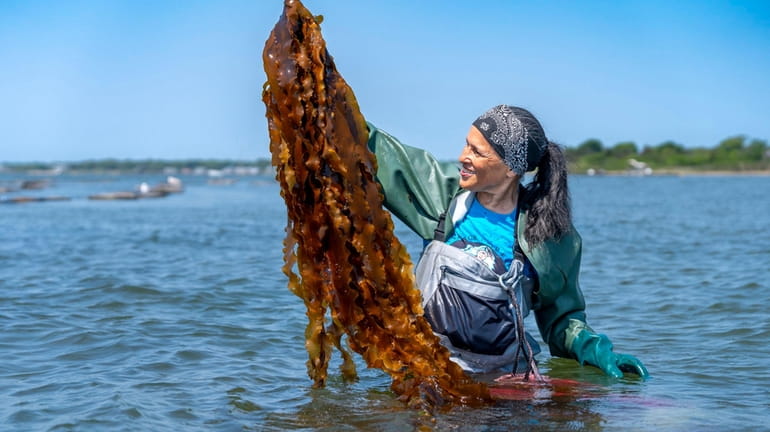
For the Long Islanders who make their living from sound and ocean, bays and inlets and salt marsh, their stories, their ways of seeing the world, explain and unite this abundant, seafood-centric region. Here we introduce readers to just a few of them, from a second-generation fisherman and “cutter” who grew a following during the pandemic to a behind-the-scenes mainstay of the clamming industry.
Jermaine Owens, North Fork Seafood
Peconic
I met Jermaine Owens in his garage-turned-cut shop, grottolike and cool, the pristine concrete floor slightly pitched for easy cleanup. There’s a professional ice machine on one wall that can produce 1,000 pounds of crushed ice in less than 24 hours; the tools of his trade on the opposite wall have a stark, utilitarian drama. Owens, 46, got his start in the business—and his work ethic—early on, when he would accompany his mother while she dropped off lunch for his dad, who filleted fish on a loading dock. By age 8 or so, he was scrubbing out buckets, and at 10, he knew how to start up the diesel engine on the F/V Peconic Star, out of Greenport. “I got to know the boats, the guys,” Owens said. “It’s so important on the water to learn to deal with people, to troubleshoot.” That, along with an early life filled with uncertainty, a grandmother who “could turn 15 cents into a dollar” and a few mentors along the way set him on a path marked by resilience, faith and a positive attitude. “I followed what was pulling me,” he explained.
Owens is athletic and moves with the agility and reflexes of a shortstop. Out on a fishing boat, he bags every catch possible; this time of year, that includes local tuna and swordfish, triggerfish and mahi-mahi. His ability to pivot came in handy when he and his longtime life partner Danielle Cullen decided to open North Fork Seafood in 2020. Things took a turn a month later when the pandemic hit. “I walked into the supermarket, and there wasn’t much there,” he said. “I realized I knew all these people with boats, and I had their numbers in my phone. I made some calls and got out my vacuum sealer. We were all helping each other.” Owens offered home delivery of ultrafresh, impeccably filleted local fish and other seafood, and the business skyrocketed; at the height of the pandemic, Owens was delivering to between 300 and 400 people across the East End. “I got real good at napping,” he said. “So I could cut through the night.” Soon, high-end restaurants such as Leon 1909 on Shelter Island started contacting him (“I like talking to chefs and owners”) and the business has continued to evolve. This summer, you’ll find Owens at weekend farmers markets in East Hampton, Sag Harbor and Port Jefferson—and you can keep tabs on what he’s catching on social media. “The freedom of creating my own income and doing it my way is worth a billion dollars,” he said. —JANE LEAR
Jermaine Owens of North Fork Seafood (631-905-1123; north-fork-seafood.square.site) sells at the following farmers markets: East Hampton on Fridays from 9 to 1 (until Sept. 8); Sag Harbor on Saturdays from 9 to 1 (until Oct. 28); and Port Jefferson on Sundays from 9 to 2 (until Nov. 11).
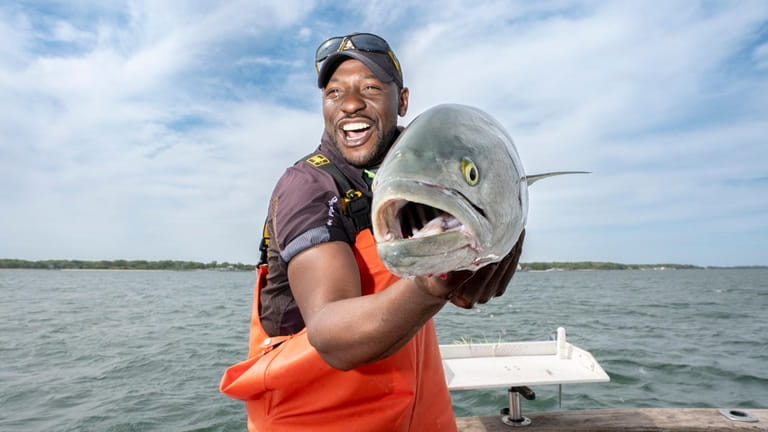
Jermaine Owens holds a 10-pound bluefish caught in the Peconic Bay. Credit: Randee Daddona
Bill Zeller and Marcus Buffaloe, Captree Clam
West Babylon
Bill Zeller, one of Long Island’s biggest clam wholesalers, has been buying clams from scores of baymen on the North and South shores for the past 50 years. Bags upon bags of clams line the floor of his Captree Clam facility in West Babylon, where they are mechanically sorted by size and graded for distribution. An affable guy with a penchant for storytelling, Zeller is also a man in transition. “It’s time to pass the torch,” he said. Enter Marcus Buffaloe. Contrary to the loquacious Zeller, Buffaloe is a more understated presence. While Zeller spun tales that involved a whole lot of hustle, Buffaloe told a story of getting out on the water to bring in some extra cash for his growing family, which is what ultimately put the men in each other’s orbits. The two have a lot in common: They both understand that success takes smarts, a little bit of luck and a great deal of hard work. In early May, Buffaloe took over Zeller’s role of president of Captree Clam. An oyster farmer and distributor following a career that began in pharmaceutical sales, Buffaloe is now learning the clam business. There are Atlantic hard-shell clams—littlenecks, middlenecks, topnecks, cherrystones, all named for their size. There are soft-shell clams, also known as steamers, belly or Ipswich clams. There are also razor clams and other varieties imported from Pacific waters that are coveted by restaurant chefs. As Buffaloe said, “Oysters, clams are both classified as shellfish, both bivalves, both filter water, so it’s more of an integration than a transition. For me, it’s about meeting the baymen, learning the bagging process, and understanding what we can do differently.” Sitting down with Captree Clams’ past and future, it’s evident that there is mutual respect. But as Zeller told it, it was his wife, Maureen, who saw Buffaloe’s ambition, something that mirrored what she saw in her own husband in those early days. “She said, ‘He’s you. He sounds like you. He has your passion, this is the right person.’ ” —MARIE ELENA MARTINEZ
Captree Clam (440 Falmouth Rd., West Babylon; 631-422-0517; captreeclam.com) has a retail shop on the property that’s open 8 to 4 daily. It’s closed on Sundays.
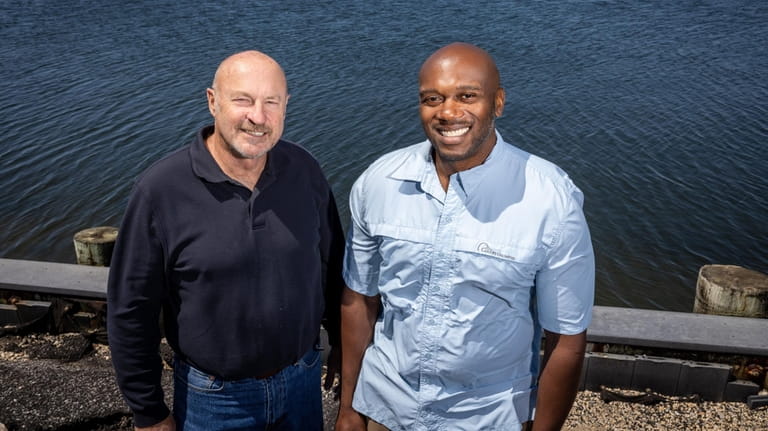
Bill Zeller, left, and Marcus Buffaloe of Captree Clam. Credit: Newsday/J. Conrad Williams Jr.
Shinnecock Kelp Farmers
Southampton
Rebecca Genia remembers when you could walk out into the waters of Shinnecock Bay and collect an entire bag of wild scallops. Shinnecock clambakes were a highlight of her childhood growing up on the reservation, she said. A hundred people would get together, every cousin she had, and bring in everything from scallops to black mussels, eels and sea snails to bake for hours in an underground oven lined with an ancient Shinnecock ingredient, seaweed. “It had this aroma—this beautiful smoky, steamy thing was going on,” she said. “Kelp is really in our DNA.” But these days, one can search for hours and not find a single bay scallop. The causes of the first mass die-off, in 2019, and subsequent others are complex and include nitrogen pollution, parasites, warmer water temperatures and lower oxygen levels (thus creating water that is too acidic). Shinnecock jewelry makers were having a tough time carving wampum from the clam shells they collected, as the acidic water made them very brittle.
Genia, who believes in an Indigenous principle that involves looking ahead to care for the next seven generations, set a plan in motion. Today she is one of six Indigenous women—along with Waban Neetskeh Tarrant, Tela Sasweena Troge, Darlene Michannock Troge, Danielle Munnannock Hopson Begun and Donna Collins-Smith—who are working to restore the East End’s waterways by farming sugar kelp through their nonprofit, Shinnecock Kelp Farmers, and they’re expanding with the aid of a $75,000 grant from The Nature Conservancy. The kelp is a natural biostimulant, meaning it can be used as a soil amendment for garden vegetables and other plants. More importantly, through photosynthesis, the kelp releases oxygen into the water, allowing sea creatures to thrive. The group now works with several partners including Stony Brook University, the Sisters of St. Joseph and the regenerative farming nonprofit GreenWave. “This beautiful kelp, it’s a gift.” Genia said. “It’s the best of both worlds to be able to help clean the waters and pass that down to your children .... We are dead serious about taking care of the seven generations. This is our way, one solution.” —ANDI BERLIN
This summer, the Shinnecock Kelp Collective will be selling their dried kelp at the East End Food Market, 139 Main Rd., Riverhead, on some Saturdays from 9 to 2 until Oct. 28.
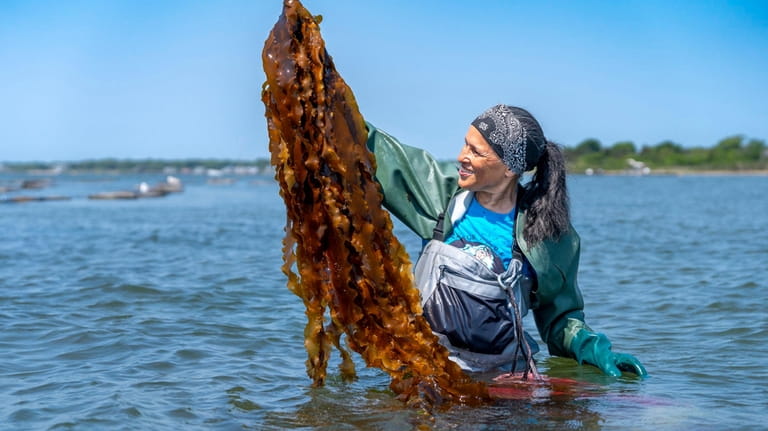
Donna Collins-Smith of the Shinnecock Kelp Farmers holds up sugar kelp from a line in Moriches Bay in Center Moriches. Credit: Randee Daddona
Kevin Halton, Two Cousins Fish Market
Freeport
Drawn in by the bachata music and the sign that says “top quality salads,” you’ll quickly notice that Two Cousins isn’t like other fish markets. Aside from the powdery strips of salt cod in the wooden crates, there’s not a fillet in sight. Instead, whole fish are scattered about on shoals of ice, shiny specimens from across the Western Hemisphere. Live fluke, a spotted flatfish from the waters around Montauk, shares a tank with crabs and catfish. A table boasts “super fresh wild Jamaican fish,” all soft pinks and reds, the colors of the sunset. Kevin Halton sits by the cash register, smiling and chatting up customers. The storied fishmonger feels right at home in this feisty little corner of Freeport’s Nautical Mile, between Hurricane Harry’s waterfront grill and a sign that says, “Congratulations, you will win a $750 fine for loud music or loud pipes, compliments of the Freeport Police Department.” Halton, who has been working on the Woodcleft Canal since 1978, would ride his bike down to the water as a kid and check out the fishing boats and increasing number of party boats. Today he manages the Two Cousins retail store (est. 1969). “I like selling people fresh fish, and I like when they come back and say, ‘That’s delicious,’ ” he said. “I had a little girl the other day who came in here with her mom. She said,
‘Mister, I love this store and I love fish. I’m six, and this is my favorite store.’ So I smiled and asked why and she said, ‘Well, it’s like a dead aquarium.’ ”
Two Cousins used to carry primarily local fish, but over the years it’s diversified to suit the thriving Caribbean community. On a recent afternoon, a couple from the West Indies was inspecting the gills of each fish, making sure they were red, which indicates freshness. Another customer, Nicolette Cooper, had traveled from Hempstead to purchase a porgy for her Jamaican escovitch, soaked in a vinegar brine with Scotch bonnet pepper. She told the fishmonger in the back room to leave the head on, because it’s nutritious and “words cannot describe” its succulent flavor. “The fish in the supermarkets are, hmm ...” she said, shaking her head. If you look on the fish here, she added, “The skin does not go in, it stays firm. That’s a fresh fish.” —ANDI BERLIN
Two Cousins Fish Market (255 Woodcleft Ave., Freeport; 516-379-0793; twocousinsfishmarket.com) is open seven days a week, 9 to 5 (fish cleaning ends a bit before 5). Closed on holidays.
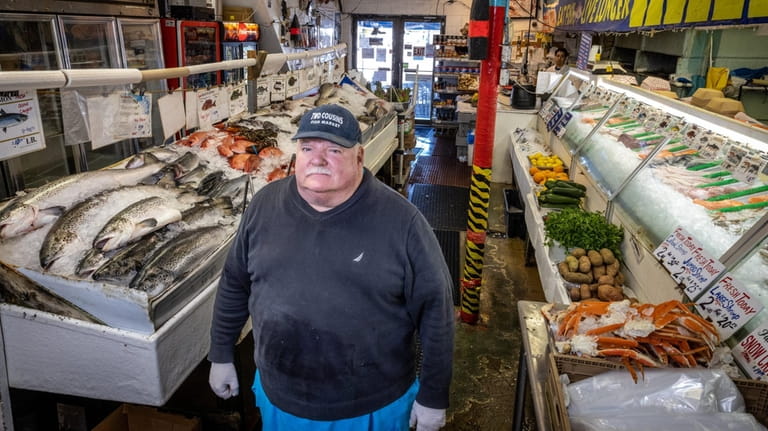
Kevin Halton of Two Cousins Fish Market in Freeport. Credit: Newsday/J. Conrad Williams Jr.
Matt Ketcham, Peconic Gold Oysters
Great Peconic Bay
“The last time we touched these was the end of October,” explained Captain Matt Ketcham, as he and his deck boss, Chase Hale, heaved an oyster cage out of Great Peconic Bay onto a barge. For the past eight years, Hale has been learning the art of oyster farming from Ketcham, a self-taught fisherman at the helm of Peconic Gold Oysters. His buttery, beautiful specimens that land on restaurant menus across the East End and beyond are the real deal—as is he, an easygoing yet ambitious father of a two-year-old son named Wyatt and a daughter on the way.
Through the six-month growing season, from May to the end of October, Ketcham is on the water daily. Today, he’s “tumbling”—a process through which growing oysters are mechanically rinsed, sorted by size, and pruned, giving the shell a nice shape so they will shuck easily and rest comfortably on a plate. Then they are put back into the water in new cages with more room to grow. Ketcham is a first-generation seaman who grew up in Patchogue, and his love of fishing started around his “fifth or seventh birthday” with his dad. He remembers it as a cold, rainy, brutal day where he only caught one fish. Fast-forward 30 years ....
Although he graduated from the aquaculture and fisheries technology program at the University of Rhode Island, Ketcham credits his experiences in the many fisheries he’s worked at for giving him the education and confidence needed to get things done. Currently, Peconic Gold has two ten-acre leases on the bay. Approximately two miles offshore, Ketcham’s farm consists of about 200 cages full of growing oysters—a number that will increase to more than 500 by the end of the summer. With about 3,500 oysters in each cage, that’s a lot of bivalves to oversee. Because it takes a fair amount of time—about one and a half to three years—to bring an oyster to market, patience is key, as is organization. Oysters aren’t just classified as big or small, Ketcham explained. “You have old oysters, young oysters, oysters that are going fast, oysters that are going slow, ugly oysters, all different stuff. It’s a stressful business, and hard work, but there’s nothing else I could picture myself doing.” —MARIE ELENA MARTINEZ
Peconic Gold’s oysters (peconicgoldoysters.com) may be found at restaurants across the East End and Braun Seafood in Cutchogue. You can also buy them at the Peconic Gold farm stand, 21125 County Rd. 48, Cutchogue. It’s on the north side of the road between Depot Road and Cox Lane.
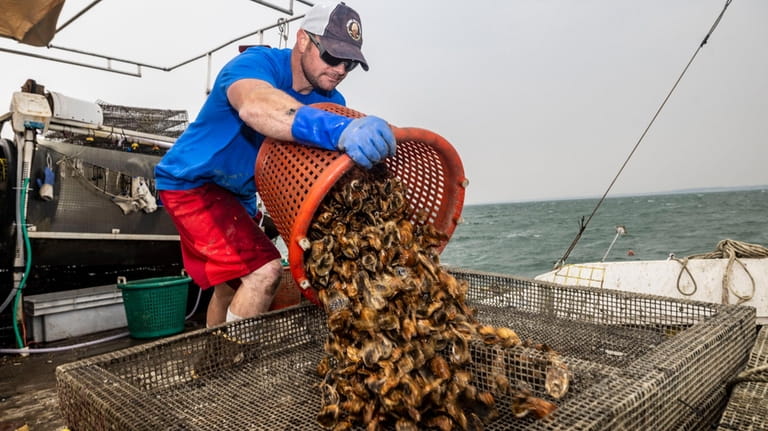
Matthew Ketcham, owner of Peconic Bay Oysters. Credit: Newsday/Alejandra Villa Loarca
